
Verbs have traditionally been defined as words that show action or state of being.

Verbs can also sometimes be recognized by their position in a sentence.
In the following two sentence frames, only a verb can be put into the empty slot.
NOUN __________ THERE ________ NOUN
(verb) (verb)
Often, prefixes and suffixes (affixes) will signify that a word is a verb. For example, the suffixes -ify, -ize, -ate, or -en usually signify that a word is a verb, as in typify, characterize, irrigate, and sweeten. Prefixes such as be-, de-, or en- may signify that a word is a verb, as in bestow, dethrone, and encourage.
These affixes, often inconsistent from verb to verb, are called derivational affixes. Added to a word, they either change the word's part of speech
Example:
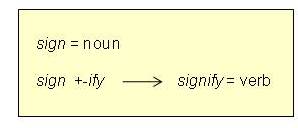
or change the word's meaning
Example:

The base form of a verb is derived from the verbís infinitive: to + verb

Four suffixes consistently added to a verbís
base create all forms of a verb used in all tenses:
1. -s
creates 3rd person
singular / present tense (He talks.)
2. -ing
creates the present participle / used with be (He
is talking.)
3. -ed creates the simple past (He talked.)
4.
-en creates the past
participle / used with have (He has talked.)
|
Note: |
The -en verb ending used with a form of to have as an auxiliary is generally written -ed, as in has talked. |
Unlike the derivational affixes, these inflectional suffixes are consistently used with all verbs, even though their form may look different from verb to verb.
Because many verbs in English are irregular; as result, their Ėed and/or Ėen endings may not follow any obvious pattern.
|
Examples: |
|
|
(to write) |
Smith writes short stories at home. (-s ending) |
|
Smith is writing short stories at home. (-ing ending) |
|
|
Smith wrote short stories at home. (-ed ending) |
|
|
Smith has written short stories at home. (-en ending) |
|
|
* |
|
|
(to buy) |
Jones buys a newspaper each day. (-s ending) |
|
Jones is buying a newspaper today. (-ing ending) |
|
|
Jones bought a newspaper yesterday. (-ed ending) |
|
|
Jones has bought newspapers every day. (-en ending) |
|
|
* |
|
|
(to go) |
Students go to the library often. (-s ending) |
|
Students are going to the library often. (-ing ending) |
|
|
Students went to the library often. (-ed ending) |
|
|
Students have gone to the library often. (-en ending) |
|
The majority of verbs are regular and consistently use -ed and -en to form their simple past tense and past participles. (e.g. talked, has talked)
Many verbs are irregular, however, and follow no consistent pattern in creating their -ed and/or -en forms. A list of the major irregular verbs is shown below.
|
Past (-ed form) |
Past Participle (-en form) |
|
|
arise |
arose |
arisen |
|
ask |
asked |
asked |
|
attack |
attacked |
attacked |
|
awaken |
awakened OR awoke |
awakened |
|
bear |
bore |
borne/born |
|
begin |
began |
begun |
|
blow |
blew |
blown |
|
break |
broke |
broken |
|
bring |
brought |
brought |
|
burst |
burst |
burst |
|
choose |
chose |
chosen |
|
cling |
clung |
clung |
|
come |
came |
come |
|
dive |
dived OR dove |
dived |
|
do |
did |
done |
|
drag |
dragged |
dragged |
|
draw |
drew |
drawn |
|
drink |
drank |
drunk |
|
drive |
drove |
driven |
|
drown |
drowned |
drowned |
|
eat |
ate |
eaten |
|
fall |
fell |
fallen |
|
fly |
flew |
flown |
|
forgive |
forgave |
forgiven |
|
freeze |
froze |
frozen |
|
get |
got |
got OR gotten |
|
give |
gave |
given |
|
go |
went |
gone |
|
grow |
grew |
grown |
|
hang (things) |
hung |
hung |
|
hang (people) |
hanged |
hanged |
|
happen |
happened |
happened |
|
know |
knew |
known |
|
lay |
laid |
laid |
|
lead |
led |
led |
|
lie |
lay |
lain |
|
loosen |
loosened |
loosened |
|
lose |
lost |
lost |
|
pay |
paid |
paid |
|
ride |
rode |
ridden |
|
ring |
rang |
rung |
|
rise |
rose |
risen |
|
run |
ran |
run |
|
see |
saw |
seen |
|
set |
set |
set |
|
shake |
shook |
shaken |
|
shrink |
shrank OR shrunk |
shrunk OR shrunken |
|
sing |
sang |
sung |
|
sink |
sank OR sunk |
sunk |
|
sit |
sat |
sat |
|
speak |
spoke |
spoken |
|
spin |
spun |
spun |
|
spit |
spat |
spat |
|
spring |
sprang OR sprung |
sprung |
|
steal |
stole |
stolen |
|
sting |
stung |
stung |
|
stink |
stank OR stunk |
stunk |
|
strive |
strove |
striven |
|
study |
studied |
studied |
|
swear |
swore |
sworn |
|
swim |
swam |
swum |
|
swing |
swung |
swung |
|
take |
took |
taken |
|
tear |
tore |
torn |
|
throw |
threw |
thrown |
|
wake |
woke OR waked |
woken OR waked |
|
wear |
wore |
worn |
|
weave |
wove |
woven |
|
wring |
wrung |
wrung |
|
write |
wrote |
written |
A verb phrase is defined as the main verb together with all its auxiliaries (helping verbs).
Auxiliary verbs always precede the main verb.
There are two types of auxiliary verbs:
1. Inflected auxiliary verbs:
|
be |
have | do |
2. Modal auxiliaries (considered more fully under (auxiliary verbs)
|
present |
past | no tense |
|
will |
would |
must |
|
shall |
should |
|
|
can |
could |
|
| may | might |
Examples of verb phrases:
|
He has taken the test. |
(auxiliary has + main verb take.) |
|
He is taking the test. |
(auxiliary is + main verb take) |
|
He did take the test. |
(auxiliary do + main verb take) |
|
He has been taking the test. |
(auxiliaries has been + main verb take) |
Verbs may be divided into three types:
|
A. Action verbs - show an action -- either physical or mental |

|
B. Verbs of being (forms of be - is, are, was, were, has/have/had been, will be) - show a state of existence: |

C. **Linking verbs - link a subject with its complement
(A subjective complement "completes" / "equals" the subject.)
Linking verbs: appear, taste, smell, feel, look, sound, grow,
seem, remain, become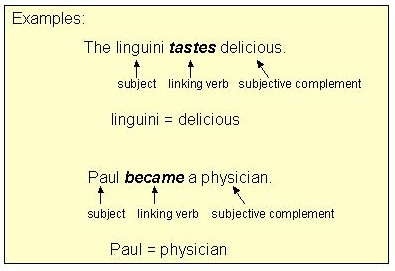
NOTE: Most linking verbs can also be used as action verbs.
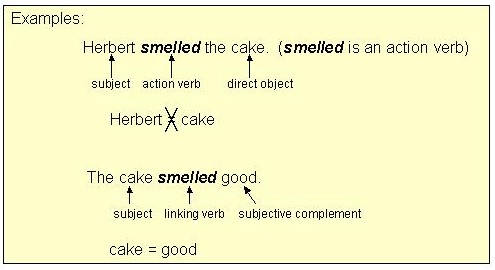
Action verbs may be either transitive or intransitive.
A. A transitive verb is one that is followed by a direct object.
Example:
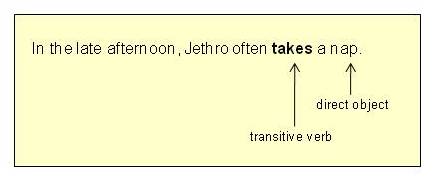
B. An intransitive verb is one that is NOT followed by a direct object.
Example:
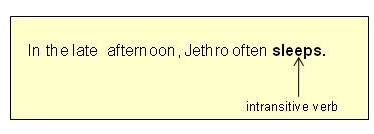
Caution: An intransitive verb may be followed by adjectives, adverbs, and/or prepositional phrases. As long as the verb is not followed by a noun or pronoun functioning as the direct object, the verb is intransitive.
Example:
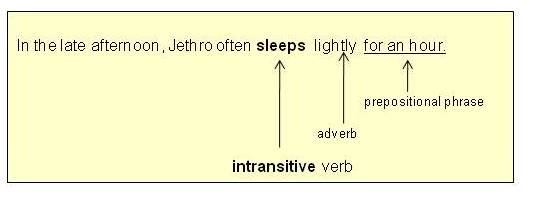
NOTE: Some action verbs may be either transitive or intransitive.
Example: (left)
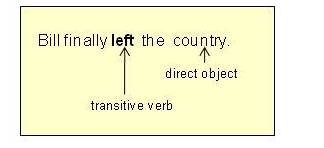
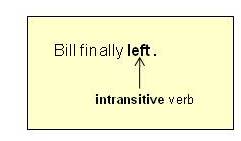
Another example (read):
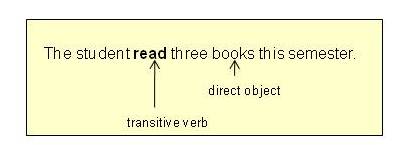
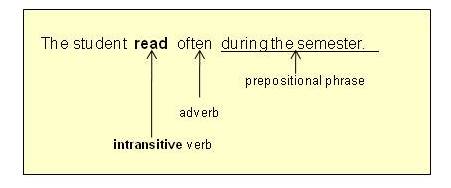
Verbs have three moods:
indicative, imperative, and subjunctive.
A. The indicative mood states a fact, asks a question, or exclaims.

B. The imperative mood gives a command. The subject is always "you" understood.

C. The subjunctive mood occurs in two instances:
|
1. The sentence indicates a situation contrary to fact. |

|
2. The sentence |
|
|
|
